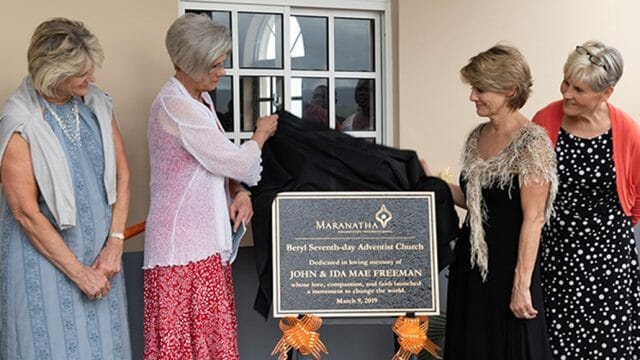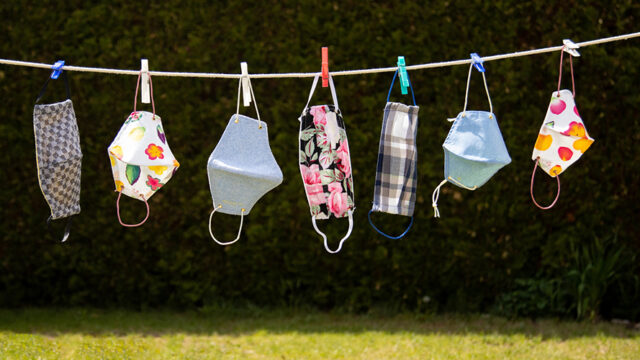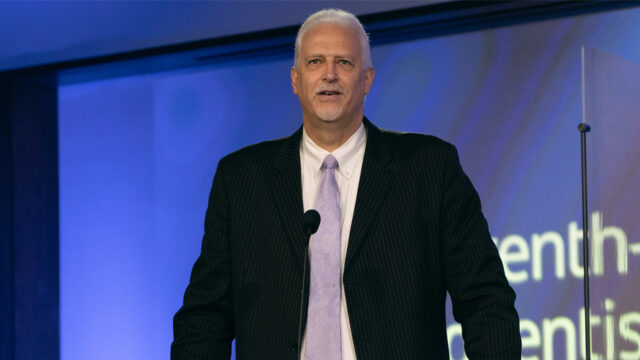Interview with Church Leaders.

Abuse of the vulnerable in many world regions dominates the headlines almost daily. Sadly, such abuse is happening not just “out there” but also within Christian homes and churches of all denominations—including among Seventh-day Adventists.
Adventist World editors Bill Knott and Gerald Klingbeil recently initiated a discussion among church leaders from the world church headquarters to ask, “What steps can we take to ensure we have a ‘safe’ church?”
Participants included General Conference Family Ministries directors Willie and Elaine Oliver; Women’s Ministries associate director Raquel Arrais; Office of General Counsel director Karnik Doukmetzian; Adventist Health Ministries director Peter Landless; General Conference general vice president Ella Simmons; Adventist Health Ministries associate director Torben Bergland; and Ministerial Association associate secretary Anthony Kent.
Watch the full interview on ARTVNow.com

BILL KNOTT: I’m going to put two words together in a phrase, and ask each of you simply to say what comes to mind when I say, “safe church.”
WILLIE OLIVER: I think of a place, an environment, where both the leadership and membership of the church are intentional about making sure that everyone in that space is going to be just fine mentally, spiritually, physically, and emotionally.
RAQUEL ARRAIS: I think about someone who listens therapeutically. Someone who is able to listen, identify, understand, and perhaps at some point even intervene.
KARNIK DOUKMETZIAN: Not having to worry about whether I’m going to get shot or abused.
ELAINE OLIVER: Similar to what Karnik said, I envision a place where I can bring my children, and they can play and feel comfortable and confident that they’re not going to get hurt; that they’re not going to get abused; that they’re not going to become victims of some type of violence.
PETER LANDLESS: I think of a place that isn’t only safe from violence but also is accepting, caring, and embracing. Violence and abuse are intentionally avoided.
ELLA SIMMONS: I resonate with what Peter was saying. I’ve rarely felt completely accepted, so for me a safe church is where every person—regardless of gender, ethnic background, cultural background—can feel completely accepted and supported to succeed or to fail.
TORBEN BERGLAND: I very much like both words of that phrase. To be safe is a fundamental need. We have to be safe. We have to feel safe. If we’re not safe, we don’t thrive and do well. When you combine the word “safe” with the word “church,” you envision a very good place. But the church is made up of people, and people are never 100 percent safe. When we’re dealing with people, there’s always the potential for something that is not good. So we must acknowledge that. We can’t take for granted that the church will be a perfectly safe place.
KNOTT: All of us are consuming national and international media reports that reference acts of violence or abuse happening in sanctuaries or other places that we always thought of as safe. For you, are there things that your own local congregation is doing to help make your church a place in which you feel safe?
WILLIE OLIVER: In our congregation we’re very intentional about how we collect the offering. We have deacons who offer the prayer and collect the offering. We also have strategically positioned deacons, close to the front of the church and the entrance at the back. Our entire deacon staff is trained by professional security guards to be security for the church during vulnerable times, such as when collecting the offering.
SIMMONS: What Willie has shared is very important; we want our finances to be safe. But in our churches our children roam around, and they need to be able to do that. Some local churches are prepared for that. My home church also has deacons and others stationed in strategic places to watch out for the children. When we have children’s church and the children leave the larger congregation and go into another chapel, we have a security system that requires the parent or guardian to register the children, to sign them in and out. The children also have name tags, and no one leaves that space without an officially designated individual or parent with identification escorting them.
KNOTT: How many of you are aware of whether your church has had some level of training on these kinds of issues? [All hands raised] Then you’re fortunate to be attending congregations that have become more aware. What percentage of Adventist congregations might be ready for this moment?
DOUKMETZIAN: Probably less than 50 percent. The North American Division has put into place a background-check requirement for all volunteers. Not just those working with children, but anyone who is volunteering in a local church. Elders, deacons, departmental directors—all have to go through a background check. We do that to protect not only the children but also to protect the individuals from a false accusation.
GERALD KLINGBEIL: If we look at the larger body of the church as well, have we done enough to assure safety in our churches? We’ve talked about children, money, physical safety. Have we done enough to ensure that no one is victimized?
DOUKMETZIAN: We can say we’ve done enough until there’s a problem, then we go back and look at it and say, “You know, we should have done that.” We can always do better. The point is to consider all the various aspects and make sure we’ve done the best we can.
ARRAIS: As a global church, since 2001 we’ve had in place a special sabbath to raise awareness about the potential for abuse. It’s a day of education for our community of faith and the surrounding communities to talk about safety, abuse, and so forth, and to provide materials and resources so that people can leave the church with more awareness of the problem and how to respond.
BERGLAND: It’s great that we have all these initiatives and programs. But while the programs and policies are good—even though there’s potential for improvement—sometimes implementation is lacking.
ANTHONY KENT: The church is a reflection of the families within that community, so it needs to branch out more into the community. We need to think about not only our own safety but also that of the wider community. The church then becomes a sanctuary, a known safe place with freedoms, where you can be yourself, where you can find faith—but you can find it in the context of safety.
LANDLESS: There also needs to be a willingness to talk about the issues. We tend to easily discuss physical safety, money safety, but then skirt the issue of abuse, which comes in many forms, such as abuse in the home. Those are areas we too often avoid.
BERGLAND: It’s important that we educate our leaders and employees, but it’s also important to educate our members and our children. They need to be able to recognize certain actions and behaviors as not acceptable, as forms of abuse that the church can’t condone. They must learn how to talk about them when they happen.
ARRAIS: It used to be taboo to talk about sensitive issues from the pulpit, but not anymore. We have plenty of training and resources in place at the General Conference level for the local churches. Today the Seventh-day Adventist Church is speaking about abuse, safety, and many other issues that few were openly discussing before.
ELAINE OLIVER: I totally agree, but we’re finding that local churches aren’t always aware of these resources. We need to utilize the platforms that people are using, and not just Facebook. Most teenagers, adolescents, and college students are on Instagram and Snapchat. We need to collaborate with younger adults so that they can share information on their social media platforms. We have to begin speaking the language that people today speak.
KENT: One of the greatest resources we have is the Bible, and it doesn’t avoid addressing these various issues of victimization, abuse, and personal trauma. We’re uncomfortable even reading some of those passages in public, but those stories are there for a reason.
KNOTT: Several of you have referenced the issue of what could be called either “domestic abuse” or “intimate partner abuse” as an unspoken backdrop to much of what’s happening in congregational life. Those of you who’ve been involved in pastoral ministry know those stories. Assess how the church is doing in addressing the issues of domestic or intimate partner violence.
WILLIE OLIVER: I think we’re doing more, and I think we’re doing better. As Raquel has mentioned, the EndItNow program offers resources along those lines. Family Ministries also frequently addresses these issues. We’ve developed television programs and workshops, and pastors are now preaching and talking about abuse. So there’s increased awareness—but more needs to be done.
SIMMONS: More can and must be done in our formal education process—pastoral education and training. We must be intentional; direct; and current in the language, the research, and the news media. Sometimes we are so caught up in what we ourselves are doing and who we are that we miss what’s happening right around us. We must be aware of everything happening in our communities. We must educate pastors for this type of interaction with the community.
BERGLAND: As a church we have a great opportunity to reach members through Sabbath School, Pathfinders, and our schools. We should address these issues in a systematic way, and set the standard as a church. These are the values that we uphold.
KLINGBEIL: I’m glad we’re discussing prevention. But as a church, what do we do when we confront these issues?
WILLIE OLIVER: Unfortunately, we haven’t done as well as we need to do to prepare for that. We’re confronting abuse more frequently, but still not addressing many of these instances. The church needs to be responsible. First, as a community of faith, we must make sure that our pastors are properly trained and sensitive not only to abuse but even the appearance of abuse. They also need to be mindful of the fact that using certain verbal language and certain body language can make people feel abused. How we speak and what we do and how we use our own bodies should convey safety.
Knott: I want to ask the women: What do you find yourself thinking when you walk into a congregation that’s new to you? How do you determine if that place is a safe place for you?
SIMMONS: We’re talking about perceptions here, but I believe we’ve become astute at reading body language. It’s more than how someone looks at you or the words they say. I look at how individuals in a new setting interact with each other—how husbands and wives interact with each other; how men and women who aren’t married interact with each other; how people interact with children. Then as I’m received into that setting—any cultural setting worldwide—that’s what gives me cues for my behavior. Sometimes we see red flags that become easily apparent, with both men and women.
ELAINE OLIVER: There has to be a paradigm shift in our church. To be candid, our churches are still very male-centered. I’ve gone to churches with Willie where leaders will say, “Only your husband is speaking. Only your husband will go on the platform during the worship service.” I have to perhaps respect the culture of this environment, but at the same time I say, “This is the Seventh-day Adventist Church. Aren’t we a worldwide body that has a belief system, a culture, policies regarding how we treat women?” So it’s a lot that women have to take in and process.
We have to wonder, when we do have issues of abuse and violence, how will people in these contexts handle these cases? Are they prepared? Are they educated enough? Are they able to separate their personal cultural beliefs from what is actually happening to create a safe environment?
ARRAIS: Elaine and Ella have given a wonderful analysis of what is going on. But we know that more women are being abused, and sometimes the church is completely silent. We totally ignore the issue. That’s why we must be able to identify, to understand, to not be suspicious or judgmental all the time, and to listen therapeutically. We need to learn how to intervene. This is where we often fail. We don’t know what to say; we don’t know where to go; we don’t know what to do. We need to create a system in collaboration with all departments that reaches the local church level.
DOUKMETZIAN: That’s one piece of it. The other piece to remember is that our churches have open doors. In other words, anyone who wants to come in off the street or otherwise is welcome. So we have to be very careful with the protection and safety of not only our adults but also our children, to make sure we have processes in place that protect our safety.
KNOTT: I want to follow up with a question for Karnik about online discussions I’ve been reading. Some very well-intentioned people suggest that when an incident of abuse is noted and comes to the attention of a congregation, it shouldn’t be reported to the authorities—that it should be handled somehow internally in the church’s system. “We shouldn’t take a brother to court” is the expression some have used. What do you say to people who reason like that?
DOUKMETZIAN: If you’re a pastor or someone who is required by law to report incidents of abuse, you have an obligation to report it, or you’ll likely end up in jail. Our job is to protect. The sooner we can get the authorities to investigate the situation—regardless of whether we believe it or not—the better. Let the authorities do their work. It doesn’t fall on us to investigate. In fact, we could mess up the investigation of the authorities if we try to investigate ourselves. My counsel always is to report it, and let the authorities handle it.
KNOTT: Even with the chance that it could create some embarrassment to the image of the church and the community?
DOUKMETZIAN: Absolutely. Because if you don’t, you’re running the risk not only of going to jail yourself, but of liability flowing to the organization.
KENT: And greater embarrassment.
WILLIE OLIVER: Our concern should be safety, not whether we embarrass the church.
DOUKMETZIAN: But we also must provide protection for the individual who’s accused, because the investigation may prove that it wasn’t a proper allegation.
ELAINE OLIVER: We also need an accurate sense of who is doing the abusing. It doesn’t just involve being aware of strangers. Otherwise, everyone else relaxes and doesn’t see the necessity for fingerprinting and background checks. We must hold everyone accountable.
SIMMONS: If we would adopt a zero-tolerance policy and perspective on all abuse issues, then all these things would fall into place, because they would be required of a zero-tolerance environment. I’m not sure that we’ve taken that step.
KLINGBEIL: Let’s talk about the spiritual dimension of safety and transparency within the church as it affects not just a local congregation but different generations. I read the other day that Millennials in various Christian denominations are leaving their churches because they see a lack of congruency between what church members say spiritually and what is really happening. So let’s talk about the spiritual dimension of this.
WILLIE OLIVER: I want to address that from the perspective of openness of the church. Ideas of younger people can sound radical to older people, so they’re often put down. I see that as a lack of safety. Safety in the church, safety in the congregation, means we have an approach of openness when someone has a different opinion, especially our younger members.
How do we develop a position where rather than saying to someone, “Oh, you’re wrong; that’s not what we believe,” we instead say, “I’ve never heard that perspective before; tell me more.” We should encourage an environment of acceptance and openness.
ARRAIS: I can give you an example of that. We can’t ignore culture and tradition, but I was in a country where I opened the microphone for about 3,000 women, to give them an opportunity to speak out. It was a courageous act because the region’s pastors were there. The information, statements, and policies in the General Conference Working Policy don’t always filter down to them. They don’t know about them. So at the local church level in some regions, women believe that abuse is a normal part of their lives and that they have to endure it.
Many of the women there had experienced domestic violence, and they heard for the first time what the Church Manual says. It was liberating for them. For the first time they were empowered to say, “Yes! The church has a provision for this, and we can safely speak out.”
BERGLAND: We should have a zero-tolerance policy based on the spiritual perspective. Abuse is the opposite of love. The fruit of love will never, ever be abuse in any form. We as a church should take a clear, strong stance for the sake of the perpetrator as well. It can be redemptive for the perpetrator.
SIMMONS: For a spiritual response we have to go to Genesis. In the beginning God instructed man and woman to be nurturing and protective of His creation. All life is supposed to be protected and nurtured. As Christians we have a greater responsibility than even those who don’t believe, because we claim to accept God’s direction and instruction in our lives. So everything we do should be all about nurturing, protecting, and extending life.
What Raquel just shared about withholding information, or spiritual guidance, from the church—that is spiritual abuse.
WILLIE OLIVER: Absolutely! The Bible is very clear. What is the culture of Scripture? It’s found in 1 Corinthians 13:4: “Love is patient, love is kind.” Galatians 5:22 tells us “the fruit of the Spirit is love, joy, peace, patience” (NASB)* This is the Christian culture; this is the Bible culture that should permeate all our communities of faith. So we need to be very clear that there’s no place for abuse, for hurting someone and relegating it to being a part of the culture. That isn’t a godly culture. That’s Satan’s culture.
KNOTT: It’s going to take courageous voices in pulpits and training sessions and in education to communicate to another generation a set of values that aren’t going to just automatically flow to them. It’s going to take intentionality, and you’ve demonstrated that here today.
Thank you for caring deeply about this issue.
*Bible texts credited to NASB are from the New American Standard Bible, copyright ©1960, 1962, 1963, 1968, 1971, 1972, 1973, 1975, 1977, 1995 by The Lockman Foundation. Used by permission.








